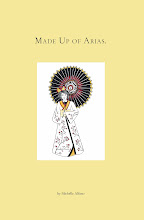I blame a more cultured friend from university who took me to my first opera. It was, luckily, Verdi’s La Traviata. I was, and largely still am, an unschooled spectator, intimidated by the length, the recitative in Italian (there were no surtitles then to aid the audience) and the grandeur of the set as it was then staged at the old O’Keefe theatre.
 |
| Maria Callas as Violetta |
I think this was a life changing moment for me in terms of how I viewed women in art. Until then I had firmly rejected all instances in art where a woman was beaten down, destroyed by the system, ruined by the dictates of family and patriarchy. Here my internal conflict begins: a part of me rebels against Violetta succumbing at all to the wishes of Alfredo’s father who wants his son to be free of the taint of his son's relationship with Violetta. I resist her sacrifice and submission and the way in which she embraces her demise.
I might have been perceived as more militant then in my cultural and literary tastes. But I saw the plot of La Traviata with new eyes. I was evolving (I hope). Verdi’s Violetta pushed me into a trickier, more complex realm of thought where I could intellectually and politically reject subordination for myself and other women and yet I could more clearly understand, feel and love this woman and the work of art she was represented in.
I can recognize now, without a trace of feminist guilt, that Violetta’s sacrifice is beautiful and meaningful in the context of her fictional world. In a manner, her sacrifice is the sacrifice that many women make for the people they love: husbands, lovers, children, in different, often less dramatic, circumstances.
It is the sacrifice that Isabel Archer makes when she decides to remain in a loveless marriage for the sake of her principles and the love of her step-daughter in The Portrait of A Lady. Or Anna Karenina’s decision to throw herself under a train for, in effect, she has been destroyed as easily and completely as her lover Vronsky’s mare during the big race. Or Lily Bart’s slow, inexorable slide into destitution in The House of Mirth as she realizes that she is friendless, poor, not longer “marketable” as a potential wife of a rich man. Yet she is, in a sense, too proud and too late, to save herself.
I am softening, bending a little, not expecting all forms of art to conform to my vision of strong, independent women with few flaws. Call it my Violetta complex.
Published in an altered format at descant.ca/blog.









1 comment:
Very good!
Post a Comment